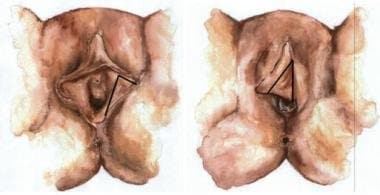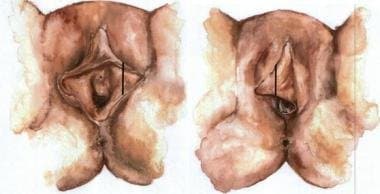Labiaplasty New York City with Dr. Cangello
Labiaplasty (Labia Surgery) for Improved Confidence
Enlarged or elongated labia can cause physical discomfort or pain during activities like exercise or sexual intercourse. In some cases, excess tissue in the labia can cause irritation or hygiene issues, leading to recurrent urinary tract infections or discomfort.
Patients often seek labiaplasty for aesthetic purposes, as this condition may cause embarrassment or feelings of self-consciousness, as the labia size can cause bulging when wearing tight clothing or bathing suits.
Labiaplasty is a surgical procedure that can address these issues and improve comfort and self-confidence by reducing the size of the labia minora and the labia majora located on the vulva.
What Is Labiaplasty?
Labiaplasty is a cosmetic surgery that involves altering the size, shape, or appearance of the labia minora or labia majora, which are the folds of skin surrounding the vaginal opening. This outpatient procedure can be performed for cosmetic reasons to improve the appearance of the labia, correct asymmetry, or for functional reasons to alleviate discomfort or irritation caused by enlarged labia.
Facts About Labiaplasty
- Labiaplasty can improve a woman’s satisfaction during intercourse.1
- According to ASPS, almost 10,000+ patients in the U.S. underwent labiaplasty in 2020.2
- The natural skin texture of the labia hides scars so well that they are undetectable after healing.3
- Labiaplasty can correct complications from enlarged labia, including pain during sex, inability to wear certain clothing, and interference during sports.
- Labiaplasty may be included as part of a customized Mommy Makeover treatment plan.
- Ideal labiaplasty candidates are in good health and have realistic expectations for the surgery.
Candidates for Labiaplasty
You are considered to be a good candidate if you are unhappy with the size and shape of the labia. You should be in relatively good health and be motivated to follow Dr. Cangello’s pre and post-operative instructions. This includes abstaining from sexual activity and tampon use while you are healing from surgery.
Labiaplasty is available to patients who are out of puberty. Having large labia can cause severe social discomfort and anxiety for young women and girls. Good candidates range from patients as young as 15 to adult women seeking rejuvenation after aging and childbirth.
Suitable candidates must also have realistic expectations for the surgery. Those who experience pain or discomfort during intercourse or with physical activity will likley have relief from those issues. By reducing the size of the inner labia to the point where they are hidden within the labia majora, patients feel much better about their physical appearance. Dr. Cangello explains the results you can expect from the labiaplasty so you feel completely confident in your procedure.
Labiaplasty Demonstration
**Warning: This video contains graphical surgical material which may not be suitable for all audiences. Viewer discretion is advised.
The Consultation: Creating Your Plastic Surgery Plan
The treatment process begins with a consultation at our New York City office. Dr. Cangello will discuss your medical history and the results you would like to achieve from your labia surgery. Dr. Cangello will ask about your goals for the labiaplasty and the look you hope to achieve. He will conduct a comprehensive physical examination to assess the extent of labial hypertrophy (overgrowth) and whether it involves the labia minora or majora only or both.
Following the physical exam, Dr. Cangello can describe additional surgical solutions that can be combined with labiaplasty as necessary.
Labiaplasty is not a procedure where one approach fits all. In fact, the key to a good outcome is a surgeon who can expertly assess your anatomy and determine the best course of action. This is where the skill of an experienced, artistically inclined board-certified plastic surgeon is essential. Dr. Cangello will recommend a treatment plan with a surgical technique that helps create the appearance you desire. During your consultation, he will answer any questions you have and provide detailed instructions on preparing for your procedure.
David L. Cangello, MD, FACS Plastic Surgery New York
Dr. David Cangello is one of the top board-certified plastic surgeons in all of New York City. His approach to treating plastic surgery with an artistic eye has successfully shaped his practice. Dr. Cangello cares about the result of the surgery as much as the patient does. Read more to learn why you should choose Dr. Cangello for your next procedure.
Schedule a ConsultationPreparing For Labiaplasty
Dr. Cangello is committed to achieving the best results possible. During your initial consultation, he will create a preoperative plan for you to follow. This plan is designed for your unique needs, to make sure that you have the best outcome possible. Your preoperative plan might include changes in diet and other habits that impact your health such as quitting smoking.
Dr. Cangello will also give you instructions for the days before your surgery. These include stopping certain medications and supplements that are blood thinners. If your procedure requires general anesthesia, you will also be instructed not to eat beginning at midnight on the day of surgery.
Finally, Dr. Cangello and his staff will explain your post-operative plan. He will give you prescriptions to fill before surgery and ask you to arrange for someone to accompany you home following surgery (if you are put to sleep). You should not shave the pubic hair immediately before surgery.

Labiaplasty Surgery Techniques
The two most common labiaplasty procedures include the wedge technique and the trim technique. Dr. Cangello prefers the wedge technique for most cases.
Wedge Technique
The wedge technique involves using a scalpel to excise a wedge-shaped piece of tissue from the rim of the labia minora. The appearance of scars is not an issue as the tissue in this area heals exceptionally well. The wedge can be designed in one of many ways depending on the shape and size of the patient’s labia. Excision options include a central, anterior, or posterior wedge or a combination. The wedge technique is best suited for patients with more extreme labial hypertrophy (excess growth).

Trim Method
The trim technique affects the labia minora. From a technical standpoint, this is the easiest method for reducing excess skin on the labia minora. As seen in the illustration below, excess labial tissue is removed along the entire edge of the labia minora. This can be efficiently executed by Dr. Cangello and takes less time, compared to the wedge technique. The tissues in this area heal exceptionally well so visible scarring is not of great concern. The trim technique is best suited for patients with minimal excess inner labial skin.

Clitoral Hood Reduction
A clitoral hood reduction is a surgical procedure that involves removing excess tissue from the clitoral hood, which is the fold of skin that covers and protects the clitoris. Enlarged labial tissue in the clitoral hood can cause discomfort during sexual activity or interfere with the ability to experience sexual pleasure. In such cases, a clitoral hood reduction can be performed to remove the excess tissue and expose more of the clitoris. This can increase sensitivity and enhance sexual pleasure for some women.
Labia Majora
The labia majora can also be treated depending on the aesthetic issue. Excessively large labia majora can be addressed by excision. A crescent-shaped piece of tissue is removed from the inner labia majora, leaving the scar hidden at the junction where the labia majora and labia minora meet. Another aesthetic concern that arises for women is that the labia majora can appear deflated. This commonly occurs after the reproductive years or after significant weight loss but can happen at any time. Treatment for this involves adding 10- 15 cc of fat by grafting the fat suctioned from another area of the body to the labia majora.
Types of Anesthesia
The type of anesthesia used depends on the extent of your procedure, your tolerance for minor discomfort, and your anxiety level. Often the procedure can be completed with local anesthetic only. Dr. Cangello uses a topical anesthetic before the injection of the local anesthesia so that the pinch of the needle is not felt. The discomfort from the numbing medicine being injected is very brief, and no pain is felt during the actual procedure. Oral medication can also be given to reduce anxiety.
While general anesthesia is not necessary for the procedure, intravenous sedation can be used so the patient sleeps through the procedure and experiences no discomfort. Dr. Cangello works with only highly experienced board-certified anesthesiologists. If the patient chooses to have sedation, they must plan to be accompanied home by a responsible adult.
The Recovery Process
When your labia surgery is complete, you will have sutures (stitches) in the area that was operated on. You will also have antibiotic ointment on the incisions and a sterile dressing covering the incisions. If you had general anesthesia for your procedure, you’ll need someone to drive you home after your procedure. Dr. Cangello offers local anesthesia as an alternate option. If your procedure is done using only local anesthesia, you do not need to have someone accompany you home.
A prescription for pain medicine will be given to you before your procedure, and you may take that as needed. You are asked to avoid medicines containing Ibuprofen or Aspirin after surgery until Dr. Cangello permits their use.
Your dressing should be removed before you go to the bathroom and you should gently cleanse the area with light soap and water afterward. The area should be pat dry with a clean towel, and the dressing should be replaced with new ones. You are permitted to shower (not bathe) 48 hours after the procedure.
A feminine pad can be used. However, tampons should be avoided for 4 (four) weeks. Avoid self-stimulation and intercourse for a minimum of four weeks. You may return to work the following day after surgery, provided you are comfortable.
You should plan to return to Dr. Cangello’s office several times during the course of your recovery for follow-up appointments to ensure you are healing well.
FAQs About Labiaplasty
The ideal candidate for a cosmetic procedure like labiaplasty is any woman who is healthy and is unhappy with the appearance of the labia minora or majora. While labiaplasty is traditionally thought of as a procedure to reduce the size of the labia minora, it can also be used to reduce the size of the labia majora. Hypertrophy (excessive growth) of the labia minora can sometimes cause pain or discomfort for women. Some women are not comfortable with the appearance of enlarged labia. Women suffering from any of these issues and others not mentioned here are good candidates for labiaplasty.
Rejuvenation of the labia majora can also be performed and this is done with Fat Grafting. With weight loss or aging the labia majora can lose their fullness. This can result in an aged appearance. Women who want to rejuvenate the appearance of the genital area sometimes combine labiaplasty with fat grafting of the labia majora.
The scars from labiaplasty are usually very inconspicuous and/or not visible at all. The skin/soft tissue of the labia heals exceptionally well and when incisions are made meticulously and strategically placed, the visibility of scars is minimized.
Patients can choose to have labiaplasty under local or general anesthesia. Dr. Cangello assists patients in making the decision as to what anesthesia type will be best suited for them based on their anxiety level and tolerance for having a procedure while awake.
The type of anesthesia used depends on the extent of your procedure, your tolerance for minor discomfort, and your anxiety level. Often the procedure can be completed with local anesthetic only. Dr. Cangello uses a topical anesthetic before the injection of the local anesthesia so that the pinch of the needle is not felt. The discomfort from the numbing medicine being injected is very brief, and no pain is felt during the actual procedure. Oral medication can also be given to reduce anxiety.
While general anesthesia is not necessary for the procedure, intravenous sedation can be used so the patient sleeps through the procedure and experiences no discomfort. Dr. Cangello works with only highly experienced board-certified anesthesiologists. If the patient chooses to have sedation, they must plan to be accompanied home by a responsible adult.
For the first few days after surgery, the labia minora and sometimes the surrounding labia majora can be bruised and swollen. The area tends to be sore and pain medication is prescribed to alleviate the pain. Patients should minimize the amount of time they spend seated or walking for the first week. They should also wear a pad within their undergarment to minimize rubbing of the undergarment on the incisions.
After the first week, soreness usually subsides and patients no longer require narcotic pain medication. Tylenol can be used as needed at this point. If the incisions itch, a cool compress may be helpful. But incisions should not be rubbed or scratched. Patients are usually comfortable enough to return to work at this point but should continue to be very conscious of minimizing rubbing or pressure on the incisions.
After about four weeks patients can return to normal activities, however, sexual activity should be delayed until 6 weeks.
Labiaplasty surgery is performed in Dr. Cangello’s AAAASF-approved operating room on-site in his office. The facility is state of the art and is equipped with all of the essential medical equipment to ensure that your procedure is extremely safe. Your safety is of utmost concern to Dr. Cangello.
References
1 Veale, D., Naismith, I., Eshkevari, E. et al. Psychosexual outcome after labiaplasty: a prospective case-comparison study. Int Urogynecol J 25, 831–839 (2014) doi:10.1007/s00192-013-2297-2
2 American Society of Plastic Surgeons. 2018 National Plastic Surgery Statistics. Available at: https://www.plasticsurgery.org/documents/News/Statistics/2018/plastic-surgery-statistics-report-2018.pdf Accessed January 24, 2020
3 American Society of Plastic Surgeons. Four common questions women have about recovery after labiaplasty. Available: https://www.plasticsurgery.org/news/blog/four-common-questions-women-have-about-recovery-after-labiaplasty Accessed January 24, 2020

